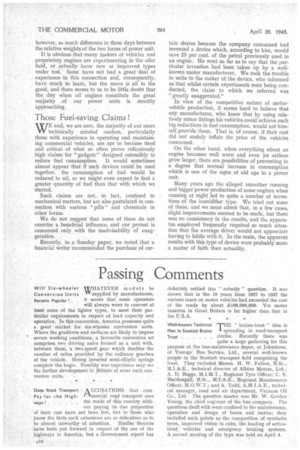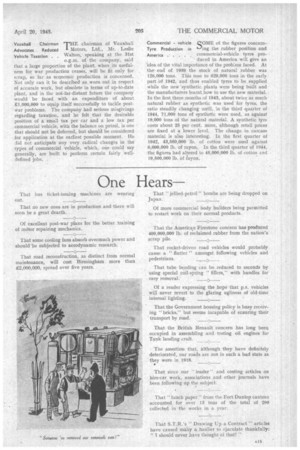Passing Comments
Page 16

Page 17

If you've noticed an error in this article please click here to report it so we can fix it.
Will Six-wheeler WHATEVER models he Conversion Units " supplied by manufacturers, Become Popular it seems that some operators will always want to convert at least some of the lighter types, to meet their particular requirements in respect of load capacity and operation. In this connection, America possesses quite a good market for six-wheeler conversion units. Where the gradients and surfaces are likely to impose severe working conditions, a favourite conversion set comprises two driving axles formed as a unit with, between them, a two-speed gear which doubles the number of ratios provided by the ordinary gearbox of the vehicle. Strong inverted semi-elliptic springs complete the bogie. Possibly war experience may see the further development in Britain of some such con version units. •
Does Road Transport• A CCUSATIONS that corn Pay for the Hi g himmercial road transport uses
ways 7 the roads of this country with out paying its due proportion of their cost have not been few, but to those who know the facts such calumnies are so ridiculous as to be almost unworthy of attention. Similar theories have bee'n put forward in respect of the use of the highways in America, but a Government report has a14 definitely settled this " subsidy " question. It was shown that in the 10 years from 1927 to 1937 the various taxes on motor vehicles had exceeded the cost oi the roads by about R.100,000,000. Yet motor taxation in Great Britain is far higher than that in the U.S.A. * «
T"" brains-trust " idea is spreading in road-transport circles. Recently there was quite a large gathering for this purpose at the bus-maintenance depot, at Johnstone, of Youngs' Bus Service, Ltd., several well-known people in the Scottish transport field comprising the trust. They included Messrs. H. W. Fulton, B.Sc., M.I.A.E., technical director of Albion Motors, Ltd.; A. D. Beggs, M.I.M.T., Regional Tyre Officer; C. S. Macdougall, B.Sc., Md.A.E., Regional Maintenance Officer, M.O.W.T.; and A. Todd, A.M.I.A.E., technical manager, road and air department, Vacuum Oil Co., Ltd. The question master was Mr. W. Gordon Young, the chief engineer of the bus company. The questions dealt with were confined to the maintenance, operation and design of buses and lorries; they included such points as the composition of synthetic tyres,. improved vision in cabs, the loading of articulated vehicles and emergency braking systems. A second meeting of the type was held on April 4.
Well-known Technical Men in Scottish Brains Trust Vauxhall Chairman THE chairman of Vauxhall Advocates Reduced I Motors, Ltd., 111r. Leslie Vehicle Taxation Walton, speaking at the 31st
o.g.m. of the company, said that a large proportion of the plant, when ,its usefulness for war production ceases, will be fit only for scrap, so far as economic production is concerned. Not only can it be described as worn out in respect of accurate work, but obsolete in terms of up-to-date plant, and in the not-far-distant future the company would be faced with an expenditure of about £1,000,000 to equip itself successfully to tackle post' war problems. The company had serious misgivings regarding taxation, and he felt that the desirable position of a small tax per car and a low tax per commercial vehicle, with the balance on petrol, is one that should not be deferred, but should be considered for application at the earliest possible moment. He did not anticipate any very radical changes in the types of commercial vehicle, which, one could say generally, are built to perform certain fairly -welldefined jobs. . Commercial vehicle QOME of the figures concernTyre Production in '•-)ing the rubber position and
America . commercial-vehicle tyres pro
duced. in America will give an 'idea of the vital importance of the problem faced. At theend of 1939 the stock of natural rubber was 126,000 tons. This 'rose to 629,000 tons in the early part :of 1942, and thus enabled tyres to be supplied while the new 'synthetic plants were being built and the manufacturers learnt .how to use the new material. In the first three months of 1943, about twice as much natural rubber • as synthetic was used for tyres, the ratio steadily changing until, in the third quarter of 1944, 71,000 tons of synthetic were used, as against 19,000 tons of the natural material. A synthetic tyre costs about 25 per cent, more, although retail prices are fixed at a lower level. The change in carcase material is alse interesting. In the first quarter of 1942, 43,500,000 lb. of cotton were used against 6,000,000 lb. of rayon. In the third quarter of 1944, the figures had altered to 45;000,000 lb. of cotton and 19,500,000 lb. of rayon.




















































